A
Auto Express
Guest
The Fiat Panda is a city car offering something a little different to rivals such as the Hyundai i10 and Skoda Citigo. Newer competitors can’t match the Panda’s personality or style, but they do offer more modern designs and better use of space inside.
Still, the Fiat Panda is a useful city car with plenty of storage spaces dotted around the cabin, as well as a generously-sized boot that expands easily thanks to a sliding rear bench.
With decent ride comfort, sprightly handling and excellent all-round visibility, the Panda is a terrific town car. On longer motorway trips, a lack of refinement from the petrol engines can become tiresome, though.
Interior trim quality doesn’t always match that of rivals, but the Panda has a solid reputation for reliability in our Driver Power satisfaction surveys.
The Fiat Panda is part of an illustrious bloodline of small cars that Fiat has had for sale over the decades. While the current car arrived in 2011, so it's one of the older cars for sale in the city car sector, it still has appeal courtesy of its quirky shape, as well as the option of Panda 4x4 and Panda Cross SUV-style versions.
Engines have come and gone, and in 2019 the standard range was stripped back so just the 1.2-litre petrol remained. The excellent TwinAir two-cylinder petrol is only found in the 4x4, while the 1.3 Multijet diesel fell off the price lists a while ago. However, there is now a Panda Mild Hybrid version available, as Fiat continues to take action to cut emissions across the range.
The Panda is slightly larger than its city car rivals, but it can count the VW up!, Citroen C1, Peugeot 108, Toyota Aygo and the Kia Picanto among its opponents. If you like your city cars Italian, then the retro Fiat 500 uses the same running gear in a design-led package.
As mentioned, an update in 2019 saw a single engine offered in the Panda hatchback, the 1.2-litre four-cylinder petrol that has been a mainstay of the range since its launch. It comes with a five-speed manual (with no option for an auto) and front-wheel drive. The standard car comes in Pop, Easy and Lounge trims, with occasional special editions, such as the Waze Edition that promotes the car's connectivity through the Uconnect system. The Mild Hybrid variant has a 1.0-litre three-cylinder petrol unit paired with a 12-volt belt-integrated starter generator and an 11Ah battery.

Fiat Panda rear tracking
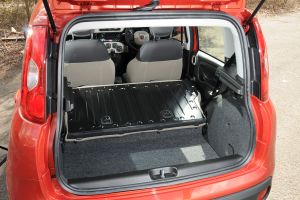
image
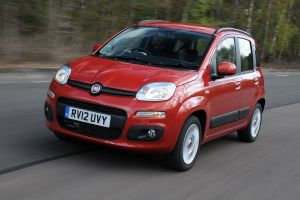
Fiat Panda front tracking

Fiat Panda badge
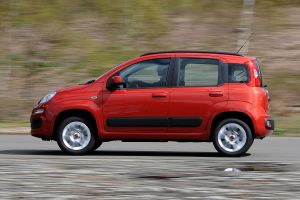
Fiat Panda panning
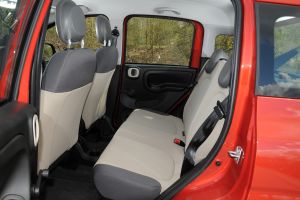
Fiat Panda rear seats
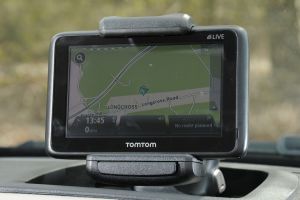
Fiat Panda sat-nav
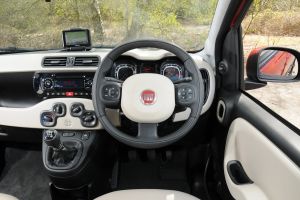
Fiat Panda interior
Then there are the Panda Cross and Panda 4x4 variants. These models add chunky body cladding, a raised ride height and mud & snow tyres to give them added off-road ability. There are two versions of the Panda Cross: the City Cross and Cross 4x4, with the former getting all the off-road kit, but sticking with front-wheel drive. The 4x4 versions get a 3 Mode terrain selector including hill descent control.
No matter which Panda you choose, you'll get fun handling, with fast steering and a nippy character. The 1.2 petrol is a little dated, so we'd try and source an older TwinAir model (or go for the Panda 4x4 which still uses it) for the best drive. All cars feature City steering that boosts the power assistance to finger-light levels at the touch of a button, making parking a doddle.
Prices for the Panda start at just over £10,000, while the City Cross is nearer £14,000 and the 4x4 in excess of £15,000. The top-spec Cross 4x4 is just over £17,000, which is a bit steep, so if you want the chunky looks, we'd settle for the City Cross, which has the show, but also the marginally lower running costs that come with its front-wheel-drive layout.
For an alternative review of the latest Fiat Panda Hatchback visit our sister site carbuyer.co.uk
Continue reading...
Still, the Fiat Panda is a useful city car with plenty of storage spaces dotted around the cabin, as well as a generously-sized boot that expands easily thanks to a sliding rear bench.
With decent ride comfort, sprightly handling and excellent all-round visibility, the Panda is a terrific town car. On longer motorway trips, a lack of refinement from the petrol engines can become tiresome, though.
Interior trim quality doesn’t always match that of rivals, but the Panda has a solid reputation for reliability in our Driver Power satisfaction surveys.
The Fiat Panda is part of an illustrious bloodline of small cars that Fiat has had for sale over the decades. While the current car arrived in 2011, so it's one of the older cars for sale in the city car sector, it still has appeal courtesy of its quirky shape, as well as the option of Panda 4x4 and Panda Cross SUV-style versions.
Engines have come and gone, and in 2019 the standard range was stripped back so just the 1.2-litre petrol remained. The excellent TwinAir two-cylinder petrol is only found in the 4x4, while the 1.3 Multijet diesel fell off the price lists a while ago. However, there is now a Panda Mild Hybrid version available, as Fiat continues to take action to cut emissions across the range.
The Panda is slightly larger than its city car rivals, but it can count the VW up!, Citroen C1, Peugeot 108, Toyota Aygo and the Kia Picanto among its opponents. If you like your city cars Italian, then the retro Fiat 500 uses the same running gear in a design-led package.
As mentioned, an update in 2019 saw a single engine offered in the Panda hatchback, the 1.2-litre four-cylinder petrol that has been a mainstay of the range since its launch. It comes with a five-speed manual (with no option for an auto) and front-wheel drive. The standard car comes in Pop, Easy and Lounge trims, with occasional special editions, such as the Waze Edition that promotes the car's connectivity through the Uconnect system. The Mild Hybrid variant has a 1.0-litre three-cylinder petrol unit paired with a 12-volt belt-integrated starter generator and an 11Ah battery.

Fiat Panda rear tracking

image

Fiat Panda front tracking

Fiat Panda badge

Fiat Panda panning

Fiat Panda rear seats

Fiat Panda sat-nav

Fiat Panda interior
Then there are the Panda Cross and Panda 4x4 variants. These models add chunky body cladding, a raised ride height and mud & snow tyres to give them added off-road ability. There are two versions of the Panda Cross: the City Cross and Cross 4x4, with the former getting all the off-road kit, but sticking with front-wheel drive. The 4x4 versions get a 3 Mode terrain selector including hill descent control.
No matter which Panda you choose, you'll get fun handling, with fast steering and a nippy character. The 1.2 petrol is a little dated, so we'd try and source an older TwinAir model (or go for the Panda 4x4 which still uses it) for the best drive. All cars feature City steering that boosts the power assistance to finger-light levels at the touch of a button, making parking a doddle.
- SEE MORE Best city cars to buy 2020
Prices for the Panda start at just over £10,000, while the City Cross is nearer £14,000 and the 4x4 in excess of £15,000. The top-spec Cross 4x4 is just over £17,000, which is a bit steep, so if you want the chunky looks, we'd settle for the City Cross, which has the show, but also the marginally lower running costs that come with its front-wheel-drive layout.
For an alternative review of the latest Fiat Panda Hatchback visit our sister site carbuyer.co.uk
Continue reading...
